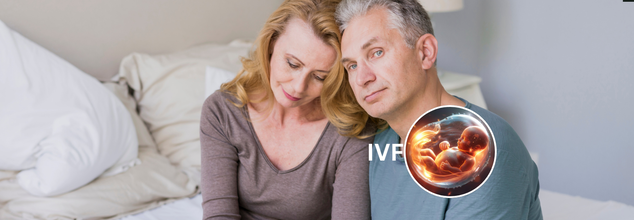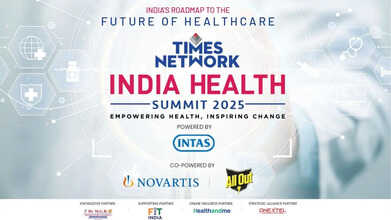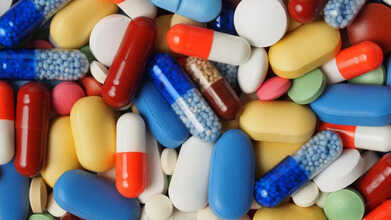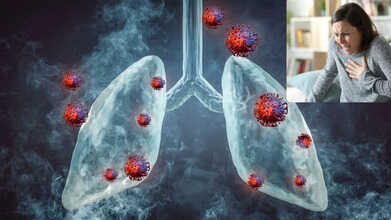- Health Conditions A-Z
- Health & Wellness
- Nutrition
- Fitness
- Health News
- Ayurveda
- Videos
- Medicine A-Z
- Parenting
- Web Stories
Is IVF After 50 Possible? Expert Breaks Down Safety and Success Rate

The idea of becoming a parent at 50 may no longer be just a distant dream. With in vitro fertilization (IVF) advancing the field of fertility care, more and more people and couples are looking into having children later in life but is IVF at or near 50 actually safe? What are the realistic prospects of success? And what does it portend for maternal health?
IVF, or in vitro fertilization, is a multi-step medical process consisting of stimulating the ovaries to release eggs, extracting those eggs, fertilizing them with sperm in the laboratory, and then placing the resultant embryo into the uterus.
We interviewed Fertility specialist, Dr. Nishi Singh Head of Prime IVF exclusively to shed light on this complex and intimate process.
"IVF is one of the most potent weapons in our fertility toolkit," says Dr. Singh. "But its potency relies a lot on the patient's age and health, particularly egg quality."
Although IVF has given millions worldwide hope, age is still the key to its success. A woman aged 20 or 30 will be successful, on average, in about 50% of IVF cycles, but this will reduce dramatically with age—to less than 10% in women aged over 40 using their own eggs.
Is IVF After 50 Possible?
"Yes, IVF at age 50 and beyond is medically feasible," affirms Dr. Singh. "But it demands subtle insight, careful planning, and medical protection to secure the safety of mother and baby."
For the woman in her late 40s or early 50s, the reduction both in quantity and quality of eggs renders natural pregnancy a rarity. Donor eggs now come to her rescue. According to Dr. Singh, "using donor eggs from younger women greatly raises the chances of conception even after menopause."
It should be noted that the uterus does not age as quickly as the ovaries. With good hormone therapy to condition the lining of the uterus, most postmenopausal women can support a pregnancy properly.
Success Rates with IVF Over 50
Dr. Singh says, "Success rates in over 50 women using donor eggs can be from 40% to 55% per cycle, depending on the clinic, embryo quality, and patient health.
This is encouraging, particularly compared to sub-10% success rates for women above 45 with the use of their own eggs. Yet while statistics hold promise, they also emphasize the need for selecting a skilled fertility clinic and personalized treatment.
Health Risks and Medical Considerations of IVF after 50
While IVF at 50 is possible, it is not without risk. "We carefully screen patients prior to moving forward," explains Dr. Singh. Regular complications include hypertension, gestational diabetes, preterm labor, and an increased risk of cesarean section.
"Patients need to be emotionally, physically, and financially ready," she warns. "Emotional readiness is just as important as biological readiness, and full counseling is an absolute component of the process."
In addition to physical well-being, parents above 50 years should be made aware of parenting responsibilities in old age, such as long-term care and energy.
What are the Ethical and Emotional Aspects Of IVF after 50?
IVF at a late age has also brought arguments over ethics and long-term consequences. While it provides biological parenthood to those women who missed the chance early in life because of careers, late marriages, or personal choices, it also raises questions about parenting at an old age.
Dr. Singh acknowledges the emotional complexities but emphasizes choice. “Everyone deserves the chance to build a family—what matters most is that they are fully informed and supported medically and emotionally.”
Expert-Recommended Tips to Improve IVF Success at Any Age
Whether you’re in your 30s or 50s, several factors can enhance your chances with IVF:
Adopt a Fertility-Boosting Lifestyle: Eat a balanced diet, exercise daily, and enjoy a healthy BMI. Reduce alcohol intake, do not smoke, and avoid recreational drugs.
Take Key Supplements: "Folic acid, CoQ10, and vitamin D can improve egg quality and overall fertility," says Dr. Singh.
Stress Management Is Key: Elevated cortisol levels can affect reproductive hormones. Practice mindfulness, yoga, or acupuncture.
Sleep Well: Aim for at least 7–8 hours of restful sleep to support hormonal balance.
Address Underlying Health Conditions: Conditions such as PCOS, thyroid issues, and endometriosis can interfere with fertility outcomes if left unmanaged.
Start Early, If Possible: The earlier IVF is initiated—especially for women over 35—the better the chances.
Work With Specialists: Choose a clinic that tailors protocols based on your individual profile.
IVF at 50 Is an Individual but a Viable Option
Thanks to advances in reproductive medicine and growing familiarity with late-age parenthood, IVF over 50 isn't merely viable—it's increasingly common. Yet it's not something to be taken lightly.
As Dr. Singh points out, "Motherhood at this age demands medical preparedness, mental toughness, and a robust support system. But with the right attitude, we've seen numerous women in their 50s achieve their dream of parenthood."
So, if you are 50 and curious whether IVF is the solution for you, just hold your horses—science is with you, but wise decision-making and professional advice are your best friends.
Dr. Nishi Singh is a Fertility specialist and Head at Prime IVF in India
The Most Coveted Gathering of India’s Healthcare Leaders: TIMES NETWORK INDIA HEALTH SUMMIT 2025

India’s healthcare leaders are set to gather at the eagerly awaited TIMES NETWORK INDIA HEALTH SUMMIT 2025. With the country positioning itself as a global healthcare hub, the Modi government is pushing reforms aimed at creating a strong healthcare system. The sector has seen remarkable changes, driven by advancements in technology, improved infrastructure, and wider accessibility. Recognizing healthcare as a strategic pillar, the government views it as essential for national growth, public welfare, and economic stability.
In 2025, healthcare will remain an essential part of India’s economy, contributing significantly to GDP growth, job opportunities, and technological progress. The industry, valued at over $500 billion, sustains millions of jobs across hospitals, pharmaceuticals, biotechnology, and health-tech. Rising demand for quality care, especially in Tier 2 and Tier 3 cities, is pushing more investments and large-scale infrastructure development.
Efforts to strengthen public health are closely aligned with the Sustainable Development Goals (SDGs), emphasizing sustainable healthcare through optimal technology use. This year, the summit will focus on key themes such as “Making Healthcare Sustainable with Optimal Use of Technology” and “Adoption of Technology for Improved Accessibility and Affordability.”
The summit will host over 30 expert speakers, 300 delegates, and eight focused knowledge sessions. Attendees will discuss shaping global healthcare standards, achieving health equity, enhancing accessibility, advancing medical education, research, and driving innovation through technology.
Notable panels include “From Policy to Practice: Making Health Equity a Reality in India”, featuring Dr Sumit Kumar Dubey, Chief Medical Officer, NDMC; Dr Randeep Guleria, Director of Medanta Medical School; and Dr Narinder Mehra, Hon. Emeritus Scientist, ICMR. Another key session, “Battling Dengue in India: Crisis, Control and the Promise of Vaccination,” will include insights from Dr Sanjeev Bagai, Chairman, Nephron Clinic, and Dr Tanu Jain, Director, NCVBDC. TV actress Chhavi Mittal, a breast cancer survivor, will also share her personal journey.
Other highlights feature Dr Ananya Awasthi, Founder & Director of Anuvaad Solutions, and Dr Meenakshi Singh, Chief Scientist, CSIR, discussing nutraceuticals; Dr Shyam Aggarwal, Chairperson Oncology at Sir Ganga Ram Hospital, on cancer care; and Arvind Pachhapur of Strands Life Sciences, exploring AI-driven healthcare solutions. Additional sessions on youth mental health and healthcare infrastructure promise to offer actionable insights for stakeholders.
For more details, visit TIMES NETWORK INDIA HEALTH SUMMIT 2025.
NHS Issues Omeprazole Warning: Safer Alternatives For Heartburn And Indigestion

Credits: Canva
NHS omeprazole warning: People who take the common heartburn and indigestion drug omeprazole have been cautioned by the NHS about its potential long-term risks. For those unversed, omeprazole belongs to a group of medicines called proton pump inhibitors (PPIs). These drugs work by reducing the amount of acid produced in the stomach and are often prescribed for acid reflux, heartburn, and related issues.
They target the stomach’s proton pumps, the enzymes responsible for producing acid. While omeprazole can be very effective, it isn’t the only solution. If you are avoiding the medicine duen to the NHS warning, or just simply struggling with side effects or prefer a more natural route, there are other options worth considering.
NHS Warning on Omeprazole’s Long-Term Use
According to new figures, nearly 73 million NHS prescriptions for PPIs like omeprazole were issued in England in 2022 to 23. Reports also show that around 15% of the UK population relies on PPIs, making them among the most commonly used medications in the country. Alongside heartburn, PPIs are used to manage conditions like indigestion, stomach ulcers, gastro-oesophageal reflux disease (GORD), and even to treat Helicobacter pylori infection when paired with antibiotics. With NHS experts now raising concerns, we spoke to a health professional who explained which safe alternatives people can turn to instead.
Alternatives to Omeprazole
Omeprazole is one of several PPIs available. This class of medication is used for GERD, stomach and duodenal ulcers, and certain bacterial stomach infections. Each drug in the group works by blocking acid pumps in the stomach, but individuals may respond differently. We got in touch with Dr Vishal Khurana, Director Gastroenterology, Metro Hospital, Faridabad who told, us, “If omeprazole causes side effects or drug interactions, switching to another PPI such as pantoprazole (Protonix) or rabeprazole (Aciphex) may be a safer option.”
Other alternatives include H2 blockers like famotidine (Pepcid AC), which reduce acid in a different way, or traditional antacids like Tums and Rolaids that provide quick but temporary relief. There are also newer prescription treatments such as vonoprazan (Voquezna) that could be considered.
Natural Remedies for Acid Reflux and Heartburn
Medication isn’t always the only answer. Many people find relief from acid reflux by making small but consistent dietary and lifestyle changes. Avoiding fatty or spicy foods, cutting back on alcohol, and eating smaller portions can all help reduce symptoms. Simple remedies like ginger tea, milk, or a small amount of apple cider vinegar may also soothe heartburn for some people.
In terms of supplements, deglycyrrhizinated licorice (DGL) has been linked to easing acid reflux, though quality can vary between brands, so it’s best to check with a pharmacist before trying.
Lifestyle habits matter too. Quitting smoking and maintaining a healthy weight have been shown to lower the risk of reflux significantly. While these changes are not always easy, their benefits go far beyond heartburn relief.
The NHS advice doesn’t mean everyone should stop using omeprazole right away, but it’s a reminder that safe alternatives exist, and making simple adjustments could help you avoid long-term risks while still keeping heartburn under control.
World Heart Day 2025: Unique Heart Attack Symptoms Often Overlooked By Women

Credits: Canva
Heart disease remains the leading cause of death for both men and women in the United States. Yet, many women experience symptoms that are not as straightforward as those seen in men, which often leads them to mistake the signs for something less serious. On this World Heart Day, it is worth pausing to look closely at the subtle symptoms women should never ignore, since they could be pointing to an underlying heart condition.
Heart Attack In Women
Chest pain is still the most recognized sign of a heart attack in both men and women. However, women are more likely to experience other discomforts that do not seem connected to the heart at first glance, like nausea, back pain, or neck stiffness. Unlike the sharp, crushing chest pain often described by men, women may feel pressure or tightness instead. In fact, some women suffer heart attacks without any chest pain at all.ALSO READ: World Heart Day 2025: How Accurate Is an ECG in Detecting Heart-Related Chest Pain?
Because these symptoms can easily be dismissed, recognizing them early becomes critical. Here are some warning signs unique to women that deserve attention:
Unique Symptoms Of Heart Attack Women Often OverlookHere are some unique symptoms that women should take note of, as per World Health Organization:
- Pain in the neck, jaw, shoulders, upper back, or stomach
- Shortness of breath
- Discomfort in one or both arms
- Nausea or vomiting
- Cold sweats
- Dizziness or lightheadedness
- Unusual tiredness
- Heartburn or indigestion
According to the Mayo Clinic, women may notice these signs when resting or even while asleep. Emotional stress also plays a bigger role in triggering heart problems in women than in men.
Interestingly, women are more likely to suffer what is known as nonobstructive coronary artery disease, where a heart attack occurs without a major blockage in the arteries. They can also develop small vessel disease, a condition in which the smaller arteries supplying blood to the heart become blocked.
Heart Risk Factors That Hit Women Harder
Traditional risk factors like high blood pressure, obesity, and high cholesterol affect both sexes. But women face additional triggers:
- Smoking poses a greater danger for women than men.
- Lack of physical activity raises the risk substantially.
- Emotional stress and depression impact women’s hearts more strongly.
- Diabetes is especially dangerous, often leading to silent heart attacks in women.
- Hormonal changes after menopause increase the risk of vessel disease.
- Pregnancy-related complications, such as high blood pressure or gestational diabetes, add to long-term risks.
- Autoimmune conditions like lupus and scleroderma heighten vulnerability.
- A family history of early heart disease is particularly significant for women under 65.
Building a Heart-Healthy Lifestyle For WomenThe good news is that many of these risks can be managed. Even small steps matter. Aim for at least 30 minutes of brisk walking or moderate activity most days. If 30 minutes feels too much at once, break it down into short sessions spread throughout the day. Over time, working toward 60 minutes of activity five days a week, along with strength training, can provide even greater protection.
As we observe World Heart Day 2025, the message is clear: women must listen to their bodies and take unusual symptoms seriously. Protecting your heart begins with awareness, lifestyle choices, and regular check-ups. A little effort today could prevent something dangerous tomorrow.
© 2024 Bennett, Coleman & Company Limited

